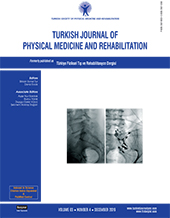Comparison of the effectiveness of partial body weight-supported treadmill exercises, robotic-assisted treadmill exercises, and anti-gravity treadmill exercises in spastic cerebral palsy
2 Department of Physical Medicine and Rehabilitation, Health Sciences University Gülhane Faculty of Medicine, Ankara, Turkey DOI : 10.5606/tftrd.2019.3078 Objectives: This study aims to compare the effectiveness of the partial body weight-supported treadmill exercise (PBWSTE), robotic-assisted treadmill exercise (RATE), and anti-gravity treadmill exercise (ATE) in children with spastic cerebral palsy (CP).
Patients and methods: Between December 01, 2015 and May 01, 2016, a total of 29 children (18 males, 11 females; mean age 9.3±2.3 years; range, 6 to 14 years) with spastic CP were included in the study. The patients were randomly divided into three groups as the PBWSTE group (n=10), RATE group (n=10), and ATE group (n=9). Each group underwent a total of 20 treadmill exercise sessions for 45 min for five days a week for a total of four weeks. The patients were assessed using three-dimensional gait analysis, open-circle indirect calorimeter, six-minute walking test, and Gross Motor Functional Measurement (GMFM) scale before and after treatment and at two months of follow-up.
Results: No significant change compared to baseline was found in the walking speed on gait analysis among the groups after the treatment. There was no statistically significant difference among the groups in terms of the GFMF-D, GMFM-E and six-minute walking test (p>0.05). There was a significant improvement in the oxygen consumption in the ATE group (p>0.05) and RATE group (p>0.05), but not in the PBWSTE group (p<0.05).
Conclusion: Our study findings indicate that all three treadmill exercises have a positive impact on walking, and RATE and ATE can be used more actively in patients with spastic CP.
Keywords : Anti-gravity treadmill exercises, cerebral palsy, gait analysis, robotic gait training
















